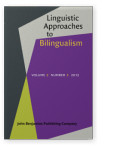Commentary
The straight and narrow path
References (16)
References
Bigelow, M., delMas, B., Hansen, K., & Tarone, E. (2006). Literacy and the processing of oral recasts in SLA. TESOL Quarterly, 40(4), 665–689. 

Bishop, D., & Mogford, K. (1988). Language development in exceptional Circumstances. London: Lawrence Erlbaum.
Brown, R. (1973). A first language. The early stages. Cambridge, MA: Harvard University Press. 

deVilliers, J., & deVilliers, P. (1973). A cross-sectional study of the acquisition of grammatical morphemes in child speech. Journal of Psycholinguistic Research, 21, 267–278. 

Ellis, R. (1990). Instructed second language acquisition. Oxford: Blackwell.
Felix, S. (1985). More evidence on competing cognitive systems. Second Language Research, 11, 47–72. 

Hawkins, R. (2001). Second language syntax: A Generative introduction. Oxford: Blackwell.
Kroch, A. (1989) Reflexes of grammar in patterns of language change. Language Variation and Change, 11, 199–244. 

Sakus. W.G., & Fodor. J.D. (2001) The structural triggers learner. In S. Bertolo (Ed.), Language acquisition and learnability (pp. 172–233). Cambridge: CUP. 

Schmidt, R. (1990). The role of consciousness in second language learning. Applied Linguistics, 111, 129–158. 

Vainikka, A., & Levy, Y. (1999) Empty subjects in Hebrew and Finnish. Natural Language and Linguistic Theory, 613–671. 

Vainikka, A., & Young-Scholten, M. (1996). The early stages in adult L2 syntax: Additional evidence from Romance speakers. Second Language Research, 121, 140–176. 

Vainikka, A., & Young-Scholten, M. . (2007). The role of literacy in the development of L2 morphosyntax from an Organic Grammar perspective. In N. Faux (Ed.), Low-educated second language and literacy acquisition. Research, Policy and Practice. Richmond, VA : The Literacy Institute.
Vainikka, A., & Young-Scholten, M. (2011). The acquisition of German: Introducing organic grammar. Berlin: de Gruyter. 

Young-Scholten, M., & Strom, N. (2006). First-time adult L2 readers: Is there a critical period? In J. Kurvers, I. van der Craats, & M. Young-Scholten (Eds.) Low educated adult second language and literacy acquisition. Amsterdam: LOT.
Cited by (2)
Cited by two other publications
Tarone, Elaine
2021.
Alphabetic Print Literacy Level and Noticing Oral Corrective Feedback in SLA. In
The Cambridge Handbook of Corrective Feedback in Second Language Learning and Teaching,
► pp. 450 ff.

This list is based on CrossRef data as of 5 july 2024. Please note that it may not be complete. Sources presented here have been supplied by the respective publishers.
Any errors therein should be reported to them.
